JQuery
JQuery
1. Jquery其实就是一个类库,集成了DOM/BOM/JavaScript的类库
http://jquery.cuishifeng.cn/ 这个网站里有所有的jQuery的方法
2. 查找元素
jQuery里有:选择器、筛选器
关于JQuery的版本
关于jQuery的版本:(现在一共有三大版本)
1系列版本
2系列版本
3系列版本
三者的区别是:1系列兼容ie的各个版本、2系列以及3系列只能支持ie8以上的浏览器
所以选择1系列,现在最新的是1.12.4版本
jQuery的导入方式
<script src="jquery-1.12.4.js"></script>
调用的时候有两种方式:
$或者jquery
下面是一个基本的例子
<head>
<meta charset="UTF-8">
<title>Title</title>
<script src="jquery-1.12.4.js"></script>
</head>
<body>
<div id="i1">test</div>
<script src="jquery-1.12.4.js"></script>
<script>
console.log($("#i1"))
console.log(jQuery("#i1"))
</script>
</body>
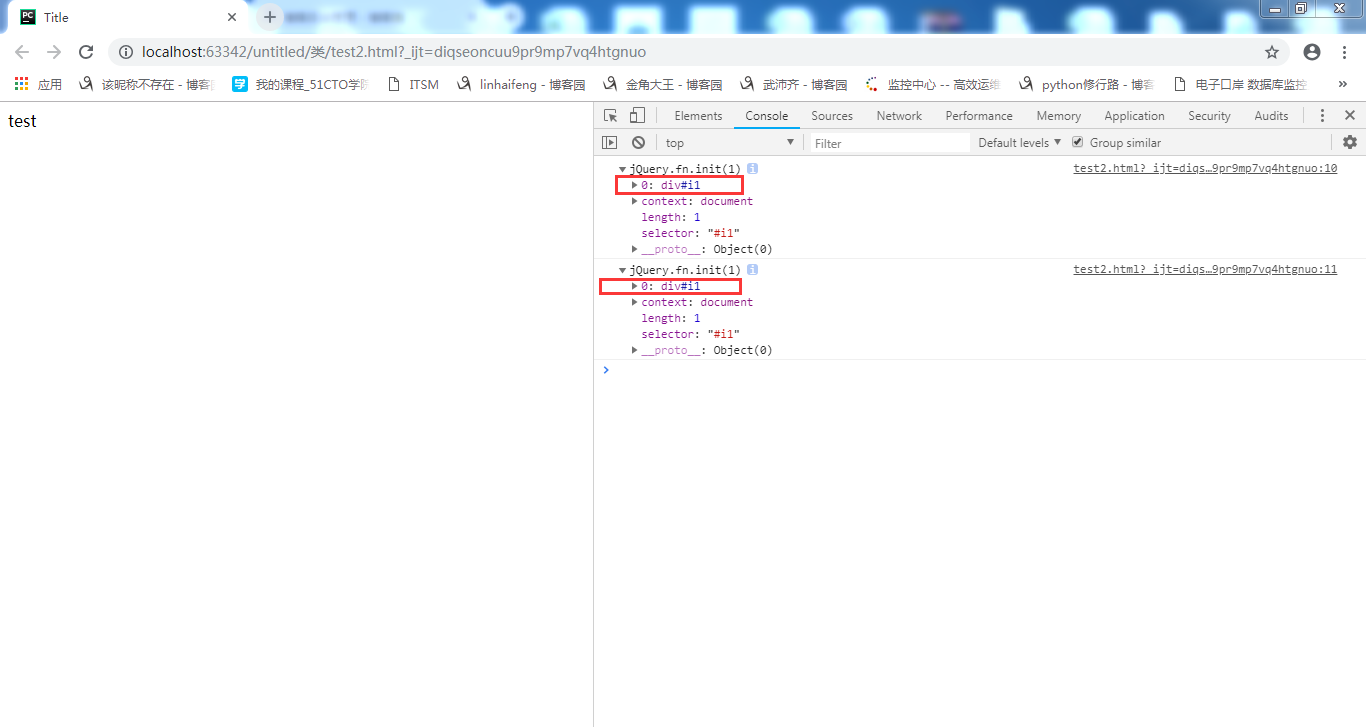
jQuery和Dom获取标签的区别即转换

还是利用上面的例子,我们可以理解为jQuery获取的是一个jQuery对象,而dom获取的直接是内容,两者之间可以相互转换
转换方法:
jQuery转换为Dom:jQuery对象[0]就可以转换为Dom内容
Dom转换为jQuery对象:$(Dom内容)
转换例子:

选择器
基本
选择器直接找到某个或者某类标签
1. id 通过id查找标签
<div id="i1"></div>
$("#id")
2. class通过class查找标签
<div class="c1"></div>
$(".c1")
3. 通过标签名直接查找
<div class="c1"> <a>zzz</a> <a>xxx</a> </div> <div class="c2"> <a>aaa</a> </div>
找到所有的a标签
$("a")
4. 组合查找
<div class="c1"> <a>zzz</a> <a>xxx</a> </div> <div class="c2"> <a>aaa</a> <div>bbb</div> </div>
找到所有的a标签以及class=c1以及class=c2的标签
$("a,.c1,.c2")
层级
1、$(".c1 a") 中间用一个空格隔开,表示子子孙孙的找
如下例所示:
<head>
<meta charset="UTF-8">
<title>Title</title>
<script src="jquery-1.12.4.js"></script>
</head>
<body>
<div class = 'c1'>
<div>
<a>bbbb</a>
</div>
<a>zzz</a>
<a>zzz</a>
</div>
</body>
查找class = 'c1'中的所有的a标签
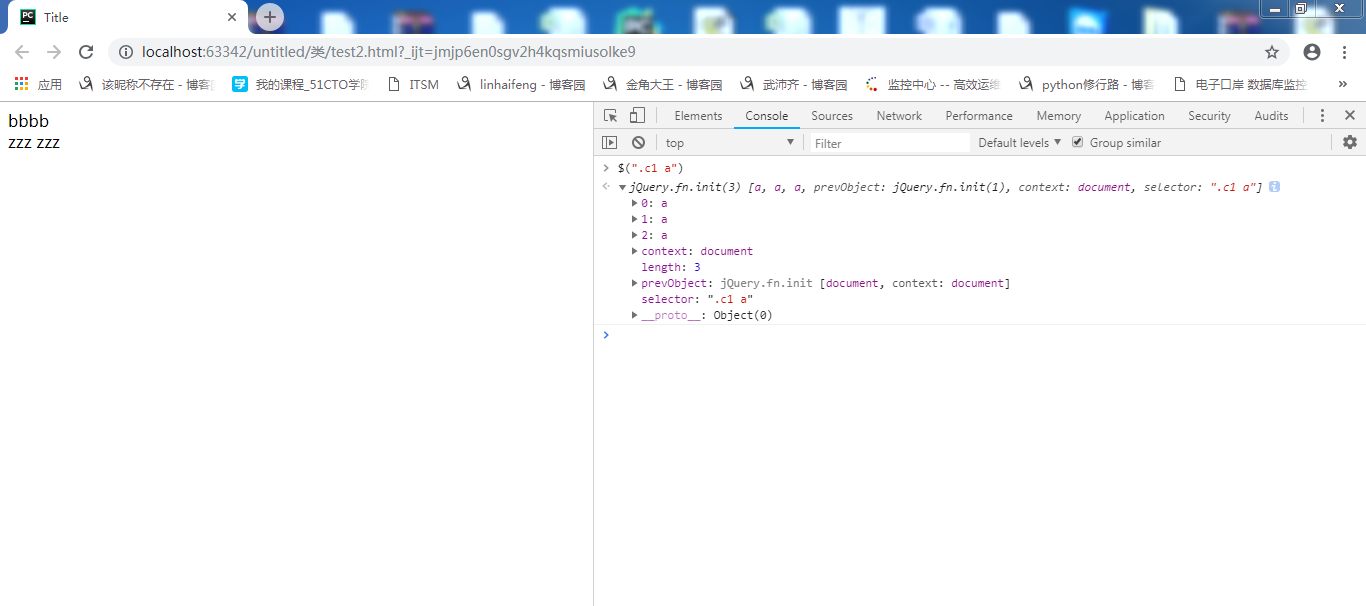
如上所示,找到了c1所在div中的所有的a标签
2. $(".c1>a")查找儿子标签

基本筛选器
查找多个标签中的第一个,通过:first
<head>
<meta charset="UTF-8">
<title>Title</title>
<script src="jquery-1.12.4.js"></script>
</head>
<body>
<div class="c1">
<a>aaa</a>
<a>bbb</a>
<a>ccc</a>
</div>
</body>
查找c1下面的第一个a标签

通过的这里存在:last查找最后一个:even奇数位,:odd偶数位
:eq(index),index从0开始
:gt(index)
属性
通过属性查找标签
<head>
<meta charset="UTF-8">
<title>Title</title>
<script src="jquery-1.12.4.js"></script>
</head>
<body>
<div class = 'c1'>
<a name = 'zs'>zzz</a>
<a name = 'ls'>bbb</a>
<a name = 'ww'>qqq</a>
</div>
</body>
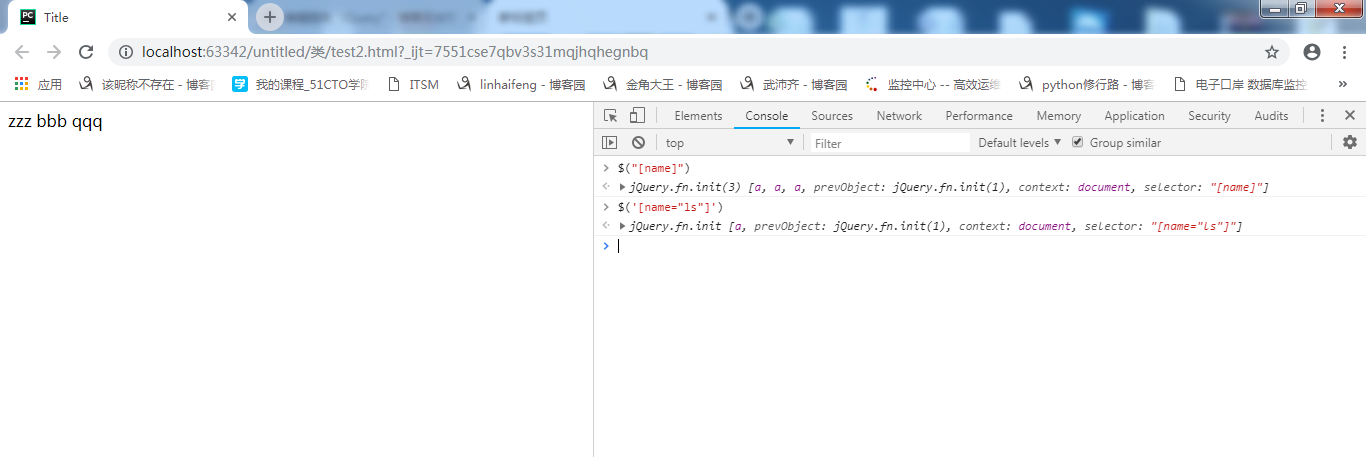
这里需要记住:
$('[name]') 查找具有name属性的标签
$('[name="ls"]') 查找具有name属性并且值为ls的标签
表单对象属性
$(':enabled')
:disabled
:checked
:selected
实现多选、反选及取消例子
<!DOCTYPE html> <html lang="en"> <head> <meta charset="UTF-8"> <title>Title</title> </head> <body> <input type="button" value="全选" onclick="checkALL()"> <input type="button" value="取消" onclick="cancleALL()"> <input type="button" value="反选" onclick="reverseALL()"> <table id ="tb1" border="1"> <thead> <tr> <th>选项</th> <th>IP</th> <th>PORT</th> </tr> </thead> <tbody> <tr> <td><input type="checkbox"></td> <td>1.1.1.1</td> <td>80</td> </tr> <tr> <td><input type="checkbox"></td> <td>1.1.1.1</td> <td>80</td> </tr> <tr> <td><input type="checkbox"></td> <td>1.1.1.1</td> <td>80</td> </tr> <tr> <td><input type="checkbox"></td> <td>1.1.1.1</td> <td>80</td> </tr> </tbody> </table> <script src="jquery-1.12.4.js"></script> <script> function checkALL() { $("#tb1 :checkbox").prop("checked",true) } function cancleALL() { $("#tb1 :checkbox").prop("checked",false) } function reverseALL() { $("#tb1 :checkbox").each(function () { // 反选这里有三种方式,第一种方式: // if(this.checked){ // this.checked=false // } // else{ // this.checked = true // } // 第二种方式: // if($(this).prop("checked")){ // $(this).prop("checked",false) // } // else{ // $(this).prop("checked",true) // } // 第三种方式:通过三元运算方式 v = $(this).prop("checked")?false:true; $(this).prop("checked",v) }) } </script> </body> </html>
这里的反选一共用了三种方法。
这里有几个只是需要知道:
$("#tb1 :checkbox").prop("checked") //获取值
$("#tb1 :checkbox").prop("checked",true) //设置值
JQuery方法内置循环:$("#tb :checkbox").xxx
v = $(this).prop("checked")?false:true;
并且要切记一个问题$("#tb1 :checkbox") #tb1和:checkbox之间要有空格
后台左侧菜单例子
实现代码如下
<!DOCTYPE html> <html lang="en"> <head> <meta charset="UTF-8"> <title>Title</title> <style> .header{ background-color: black; color: wheat; } .content{ min-height: 50px; } .hide{ display: none; } </style> </head> <body> <div style="height:400px;width: 200px;border: 1px solid #dddddd"> <div class="item"> <div class="header">标题一</div> <div id="i1" class="content hide">内容</div> </div> <div class="item"> <div class="header">标题二</div> <div class="content hide">内容</div> </div> <div class="item"> <div class="header">标题三</div> <div class="content hide">内容</div> </div> </div> <script src="jquery-1.12.4.js"></script> <script> $(".header").click(function () { // $(this).next().removeClass('hide') // $(this).parent().siblings().find('.content').addClass('hide') $(this).next().removeClass('hide').parent().siblings().find('.content').addClass('hide') }) </script> </body> </html>
这里有几个知识需要注意:
$(this).next().removeClass('hide').parent().siblings().find('.content').addClass('hide')这种编程方式叫做链式编程
还有就是jQuery的绑定事件的方式:
$(".header").click通过这种方式就可以给所有的class=header的标签绑定click事件
筛选器中的几个用法:
$(this).next() 下一个
$(this).prev() 上一个
$(this).parent() 父
$(this).children() 孩子
$('#i1').siblings() 兄弟
$('#i1').find('#i1') 子子孙孙中查找
jQuery添加和移除样式方法:
$('#i1').addClass(..)
$('#i1').removeClass(..)
筛选
$('#i1').next()
$('#i1').nextAll()
$('#i1').nextUntil('#ii1')
$('#i1').prev()
$('#i1').prevAll()
$('#i1').prevUntil('#ii1')
$('#i1').parent()
$('#i1').parents()
$("#i1").parentsUntil()
$('#i1').children()
$('#i1').siblings()
$('#i1').find()
关于文本操作
$(..).text() //获取文本内容
$(..).text(“<a>1</a>”) // 设置文本内容
$(..).html()
$(..).html("<a>1</a>")
对于input系列以及textarea 以及select获取和设置是通过val
$(..).val()
$(..).val(..)
样式操作
removeClass //删除样式
addClass //添加样式
toggleClass
这里通过toggleClass可以实现一个开灯关灯的效果
代码例子如下:
<!DOCTYPE html> <html lang="en"> <head> <meta charset="UTF-8"> <title>Title</title> <style> .hide{ display: none; } </style> </head> <body> <input id = "i1" type="button" value="开/关"> <div class="c1 hide">aaa</div> <script src="jquery-1.12.4.js"></script> <script> $("#i1").click(function () { // if($(".c1").hasClass('hide')){ // $(".c1").removeClass('hide') // }else{ // $(".c1").addClass('hide') // } $(".c1").toggleClass('hide'); }) </script> </body> </html>
实现效果如下
默认情况下:

当点击 开/关图标时:

代码中注释的部分:
// if($(".c1").hasClass('hide')){ // $(".c1").removeClass('hide') // }else{ // $(".c1").addClass('hide') // }
实现的效果和下面代码是一样的:
$(".c1").toggleClass('hide');
属性操作
$(..).attr() 专门用于做自定义属性操作,可以获取属性值,设置属值
$(..).removeAttr 可以删除属性
例子如下:
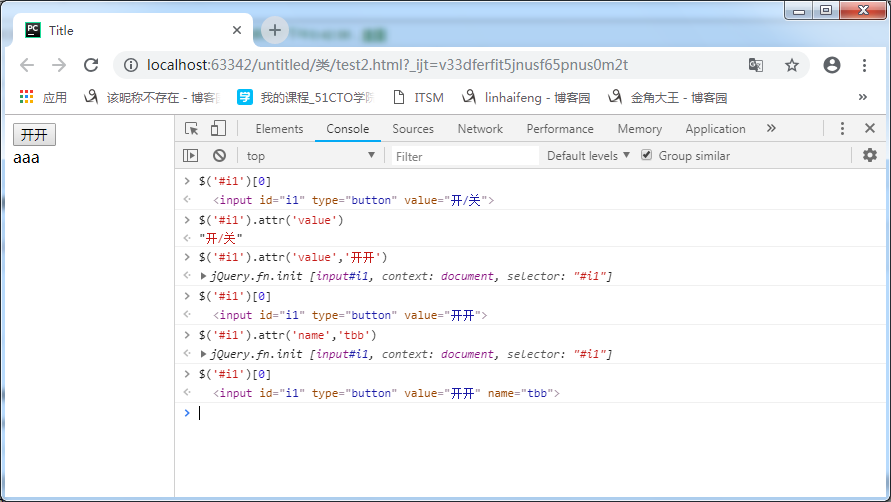
$(..).prop 专门用于checkbox,radio做操作
在3版本以下的jQuery中存在一个问题,效果如下:
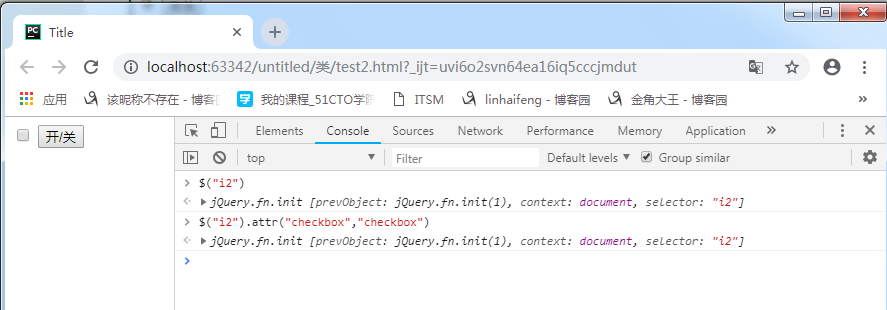
当设置为选中后再取消:
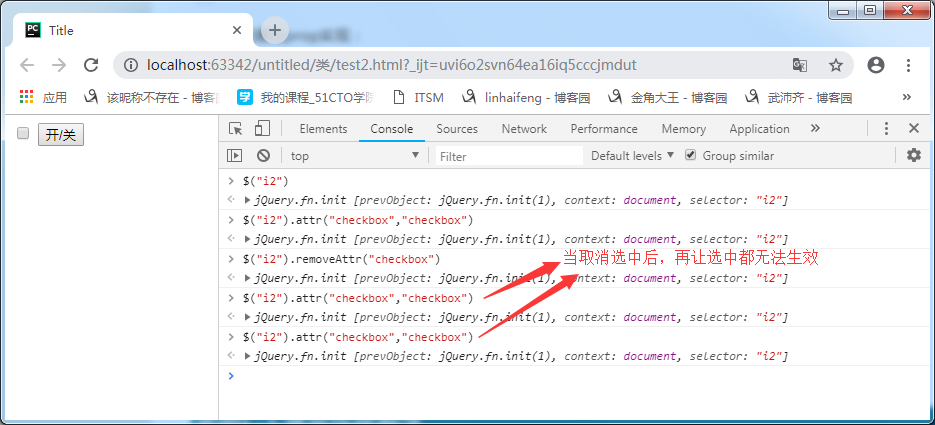
所以这里通过prop实现:
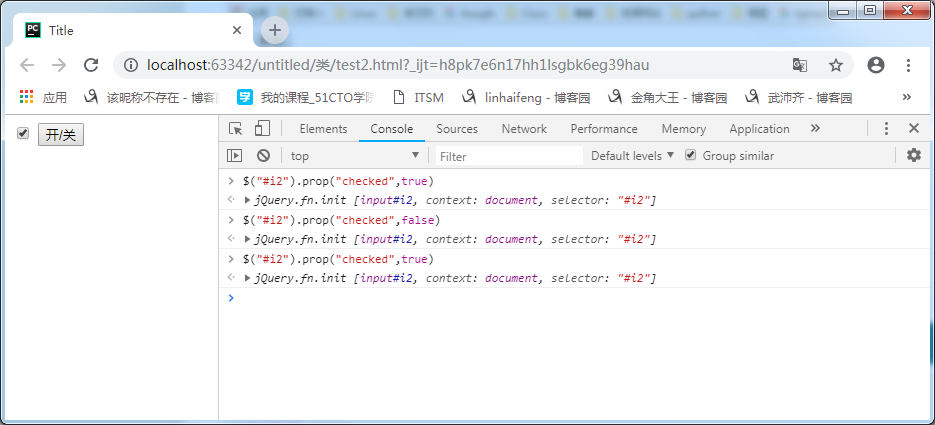
模块对话框升级版例子
<!DOCTYPE html> <html lang="en"> <head> <meta charset="UTF-8"> <title>Title</title> <style> .hide{ display: none; } .modal{ position: fixed; top: 50%; left: 50%; width: 500px; height: 400px; margin-left: -250px; margin-top: -250px; background-color: #eeeeee; z-index: 10; } .shadow{ position: fixed; top: 0; left: 0; right: 0; bottom: 0; opacity: 0.6; background-color: black; z-index: 9; } </style> </head> <body> <a onclick="addElement();">添加</a> <table border="1" id="tb"> <tr> <td target="hostname">1.1.1.11</td> <td target="port">80</td> <td target="ip">1.1.1.11</td> <td> <a class="edit">编辑</a> | <a class="del">删除</a> </td> </tr> <tr> <td target="hostname">1.1.1.12</td> <td target="port">80</td> <td target="ip">1.1.1.12</td> <td> <a class="edit">编辑</a> | <a class="del">删除</a> </td> </tr> <tr> <td target="hostname">1.1.1.13</td> <td target="port">80</td> <td target="ip">1.1.1.13</td> <td> <a class="edit">编辑</a> | <a class="del">删除</a> </td> </tr> <tr> <td target="hostname">1.1.1.14</td> <td target="port">80</td> <td target="ip">1.1.1.14</td> <td> <a class="edit">编辑</a> | <a class="del">删除</a> </td> </tr> </table> <div class="modal hide"> <div> <input name="hostname" type="text" /> <input name="port" type="text" /> <input name="ip" type="text" /> </div> <div> <input type="button" value="取消" onclick="cancleModal();" /> <input type="button" value="确定" onclick="confirmModal();" /> </div> </div> <div class="shadow hide"></div> <script src="jquery-1.12.4.js"></script> <script> function addElement() { $(".modal,.shadow").removeClass('hide') } function cancleModal() { $(".modal,.shadow").addClass('hide'); $(".modal input[type='text']").val(""); } $(".edit").click(function () { $(".modal,.shadow").removeClass('hide') var tds = $(this).parent().prevAll(); tds.each(function () { var n = $(this).attr('target'); var text = $(this).text(); $(".modal input[name="+n+"]").val(text) }) }) $(".del").click(function () { $(this).parent().parent().remove(); }) // function confirmModal() { // var tr = document.createElement('tr'); // var td1 = document.createElement('td'); // td1.innerHTML="192.168.1.1"; // var td2 = document.createElement('td'); // td2.innerHTML="8080"; // $(tr).append(td1); // $(tr).append(td2); // $("#tb").append(tr); // $(".modal,.shadow").addClass('hide'); // } </script> </body> </html>
实现Tab菜单功能例子
<!DOCTYPE html> <html lang="en"> <head> <meta charset="UTF-8"> <title>Title</title> <style> .hide{ display: none; } .menu{ height: 38px; background-color: #eeeeee; line-height: 38px; } .active{ background-color: brown; } .menu .menu-item{ float: left; border-right: 1px solid red; padding: 0 5px; cursor: pointer; } .content{ min-height: 100px; border: 1px solid #eeeeee; } </style> </head> <body> <div style="width: 700px;margin:0 auto"> <div class="menu"> <div class="menu-item active" a="1">菜单一</div> <div class="menu-item" a="2">菜单二</div> <div class="menu-item" a="3">菜单三</div> </div> <div class="content"> <div b="1">内容一</div> <div class="hide" b="2">内容二</div> <div class="hide" b="3">内容三</div> </div> </div> <script src="jquery-1.12.4.js"></script> <script> $('.menu-item').click(function () { $(this).addClass("active").siblings().removeClass("active") var v =$(this).attr('a') $('.content').children("[b='"+v+"']").removeClass('hide').siblings().addClass('hide') }) </script> </body> </html>
实现效果如下:
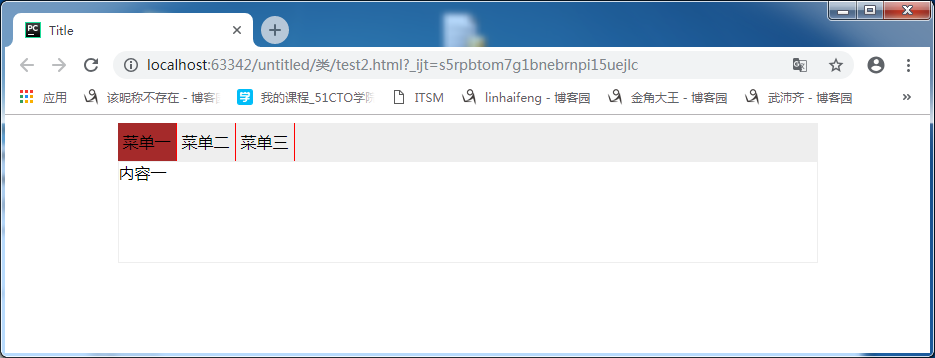
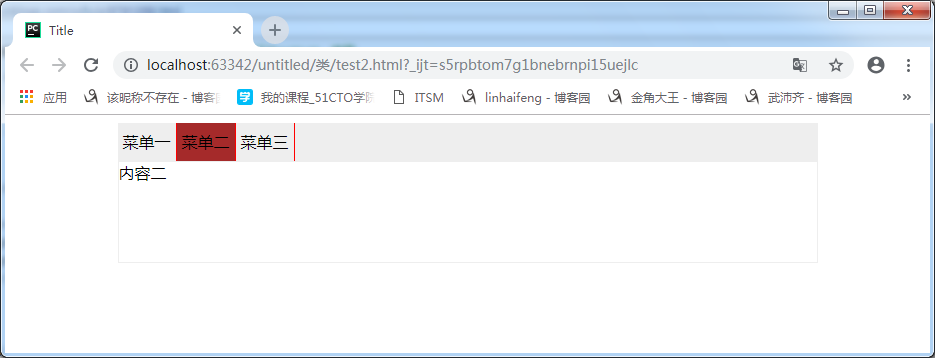
上面是通过外加属性实现的,还可以通过索引实现,这样就不用额外添加属性
可以将下面两行代码进行替换:
var v =$(this).attr('a') $('.content').children("[b='"+v+"']").removeClass('hide').siblings().addClass('hide')
替换为:
$('.content').children().eq($(this).index()).removeClass('hide').siblings().addClass('hide')
同样可以实现上述的效果。
文档处理
$("#u1").append(temp) 这个是在当前标签子标签里的后面追加
$("#u1").prepend(temp) 这个是在当前标签子标签里的前面追加
$("#u1").after(temp) 这个是作为当前标签的兄弟标签的后面添加
$("#u1").before(temp) 这个是作为当前标签的兄弟标签的前面添加
$('#u1 li').eq(index).remove() 这个是删除
$('#u1 li').eq(index).empty() 这个是将标签的值清空
var v = $("#u1 li").eq(index).clone(); 这个是克隆内容
代码例子如下:
<!DOCTYPE html> <html lang="en"> <head> <meta charset="UTF-8"> <title>Title</title> </head> <body> <input id ="a1" type="text"> <input id ="t1" type="button" value="添加"> <input id ="t2" type="button" value="删除"> <input id ="t3" type="button" value="复制"> <u1 id ="u1"> <li>1</li> <li>2</li> </u1> <script src="jquery-1.12.4.js"></script> <script> $("#t1").click(function () { var v = $("#a1").val(); console.log(v) var temp = "<li>"+v+"</li>"; // $("#u1").append(temp) $("#u1").prepend(temp) // $("#u1").after(temp) // $("#u1").before(temp) }) $("#t2").click(function () { var index = $("#a1").val(); // $('#u1 li').eq(index).remove() $('#u1 li').eq(index).empty() }) $("#t3").click(function () { var index = $("#a1").val(); var v = $("#u1 li").eq(index).clone(); $("#u1").append(v); }) </script> </body> </html>
CSS处理
$("t1").css('样式名称','样式值')
下面一个例子实现类似抽屉网的点赞功能

代码如下:
<!DOCTYPE html> <html lang="en"> <head> <meta charset="UTF-8"> <title>Title</title> <style> .container{ padding: 50px; border: 1px solid #dddddd; } .item{ position: relative; width: 30px; } </style> </head> <body> <div class="container"> <div class="item"> <span>赞</span> </div> </div> <div class="container"> <div class="item"> <span>赞</span> </div> </div> <div class="container"> <div class="item"> <span>赞</span> </div> </div> <div class="container"> <div class="item"> <span>赞</span> </div> </div> <script src="jquery-1.12.4.js"></script> <script> $(".item").click(function () { //绑定click事件,并调用AddFavor函数 AddFavor(this); }) function AddFavor(self) { //设置初始的字体大小,位置及透明度 var fontSize = 15; var top = 0; var right = 0; var opacity = 1; //创建一个span标签,并为其设置初始的css样式 var tag = document.createElement("span"); $(tag).text("+1"); $(tag).css("color","green"); $(tag).css("position",'absolute'); $(tag).css("fontSize",fontSize+"px"); $(tag).css("right",right); $(tag).css("top",top); $(tag).css("opacity",opacity) $(self).append(tag); //设置定时器,自动更改样式 var obj = setInterval(function () { fontSize = fontSize+10; top = top-10; right = right - 10; opacity = opacity - 0.1; //将更改后的样式设置到标签上 $(tag).css("fontSize",fontSize+"px"); $(tag).css('right',right+"px"); $(tag).css('top',top); $(tag).css('opacity',opacity); //当标签的透明度小于0的时候将标签以及定时器删除 if(opacity<0){ clearInterval(obj) $(tag).remove(); } },40) } </script> </body> </html>
位置
$(window).scrollTop() 获取 注意切记这里是window而不是windows,并且这里不需要引号
$(window).scrollTop(0) 设置
上面两个表示的是windows窗体的
scrollLeft() 和scrollTop一样
代码如下:
<!DOCTYPE html> <html lang="en"> <head> <meta charset="UTF-8"> <title>Title</title> </head> <body> <!--<div id="i1"></div>--> <div style="height: 100px;width:100px;overflow: auto"> <p>asdf</p><p>asdf</p><p>asdf</p><p>asdf</p><p>asdf</p><p>asdf</p><p>asdf</p> <p>asdf</p><p>asdf</p><p>asdf</p><p>asdf</p><p>asdf</p><p>asdf</p><p>asdf</p> <p>asdf</p><p>asdf</p><p>asdf</p><p>asdf</p><p>asdf</p><p>asdf</p><p>asdf</p> <p>asdf</p><p>asdf</p><p>asdf</p><p>asdf</p><p>asdf</p><p>asdf</p><p>asdf</p> <p>asdf</p><p>asdf</p><p>asdf</p><p>asdf</p><p>asdf</p><p>asdf</p><p>asdf</p> <p>asdf</p><p>asdf</p><p>asdf</p><p>asdf</p><p>asdf</p><p>asdf</p><p>asdf</p> </div> <div id="i1" style="height: 1000px"></div> <script src="jquery-1.12.4.js"></script> </body> </html>
效果如下:
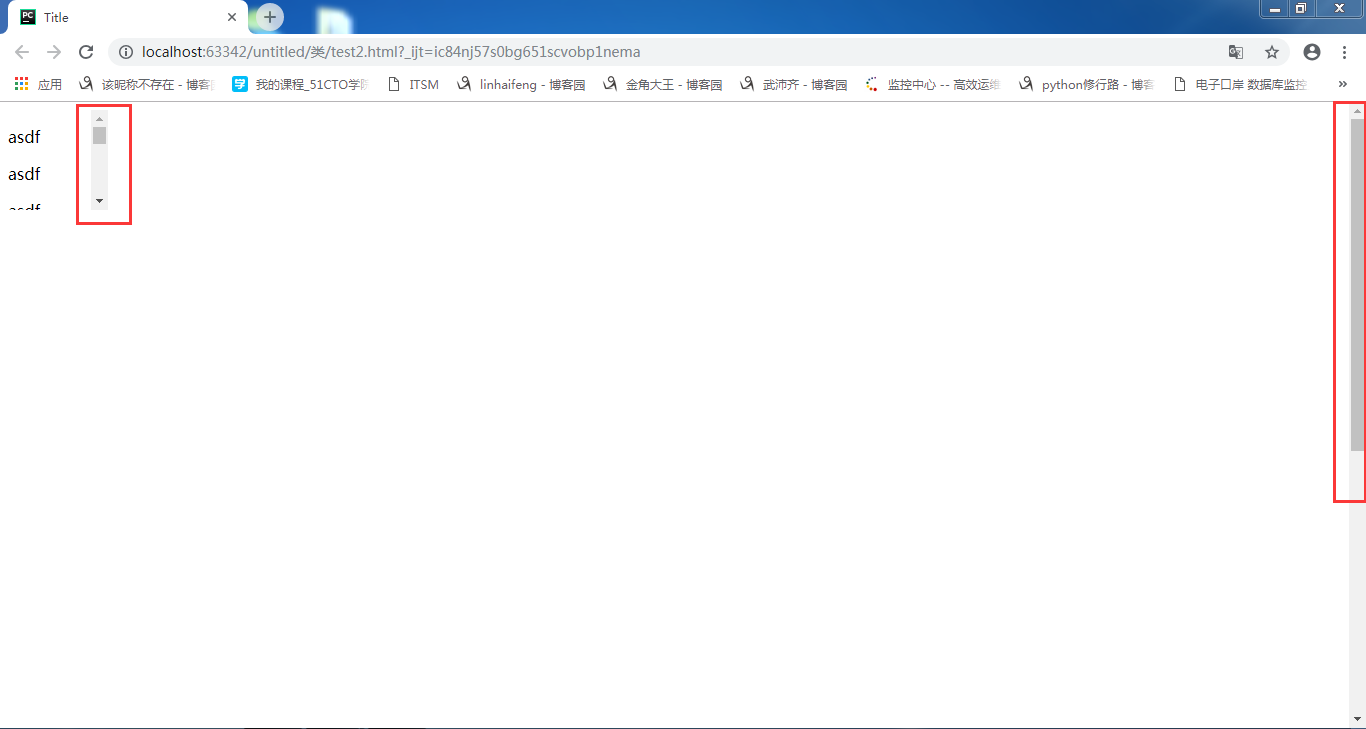
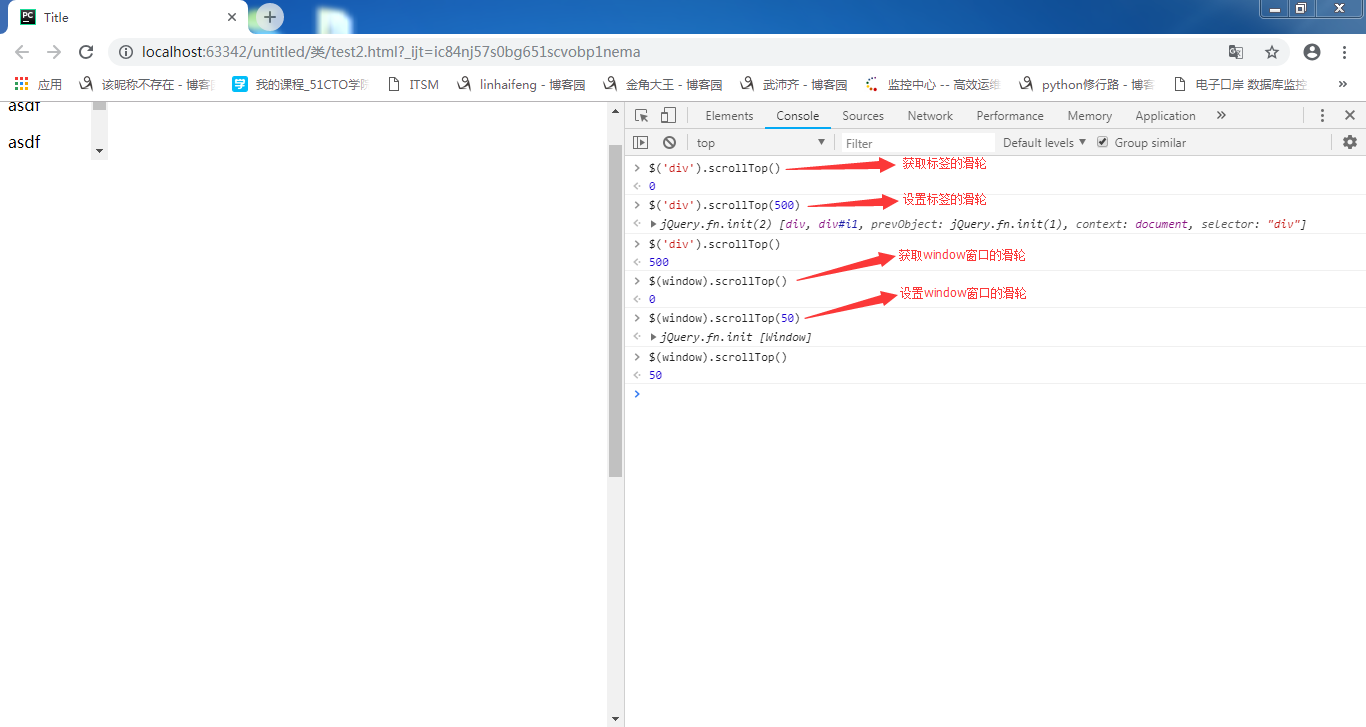
offset 获取指定标签在html中的坐标
$("#i1").offset().left 获取指定的坐标
$("#i1").offset().top 获取指定的坐标
代码例子如下:
<!DOCTYPE html> <html lang="en"> <head> <meta charset="UTF-8"> <title>Title</title> </head> <body> <div id="i1"></div> <div style="height: 100px;width:100px;overflow: auto"> <p>asdf</p><p>asdf</p><p>asdf</p><p>asdf</p><p>asdf</p><p>asdf</p><p>asdf</p> <p>asdf</p><p>asdf</p><p>asdf</p><p>asdf</p><p>asdf</p><p>asdf</p><p>asdf</p> <p>asdf</p><p>asdf</p><p>asdf</p><p>asdf</p><p>asdf</p><p>asdf</p><p>asdf</p> <p>asdf</p><p>asdf</p><p>asdf</p><p>asdf</p><p>asdf</p><p>asdf</p><p>asdf</p> <p>asdf</p><p>asdf</p><p>asdf</p><p>asdf</p><p>asdf</p><p>asdf</p><p>asdf</p> <p>asdf</p><p>asdf</p><p>asdf</p><p>asdf</p><p>asdf</p><p>asdf</p><p>asdf</p> </div> <div id="i2"></div> <div style="height: 1000px"></div> <script src="jquery-1.12.4.js"></script> </body> </html>
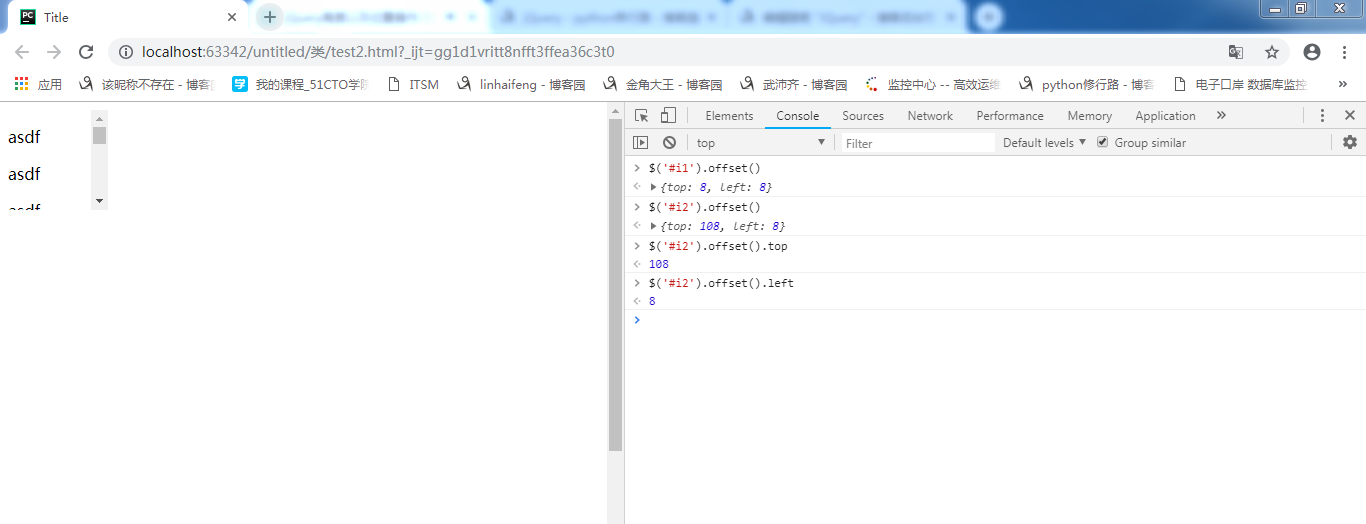
position() //指定标签相对父标签(relative)标签的坐标,如下:
<div style="relative"> <div> <div id="i1" style="position: absolute;"></div> </div> </div>
这里有几个高度需要注意:
.height()获取当前标签的高度
.innerHeight()获取自身高度+padding
.outerHeight() :
参数:false-->获取自身高度+padding+border;
参数:true--->获取自身高度+padding+border+margin;
默认是false即获取自身高度+padding+border
通过如下例子演示:
<!DOCTYPE html> <html lang="en"> <head> <meta charset="UTF-8"> <title>Title</title> </head> <body> <div style="position:relative;"> <div> <div id = "i1" style="position: absolute;height: 80px;width: 200px;padding:3px 0;margin:2px;border: 4px solid #dddddd"></div> </div> </div> <script src="jquery-1.12.4.js"></script> </body> </html>
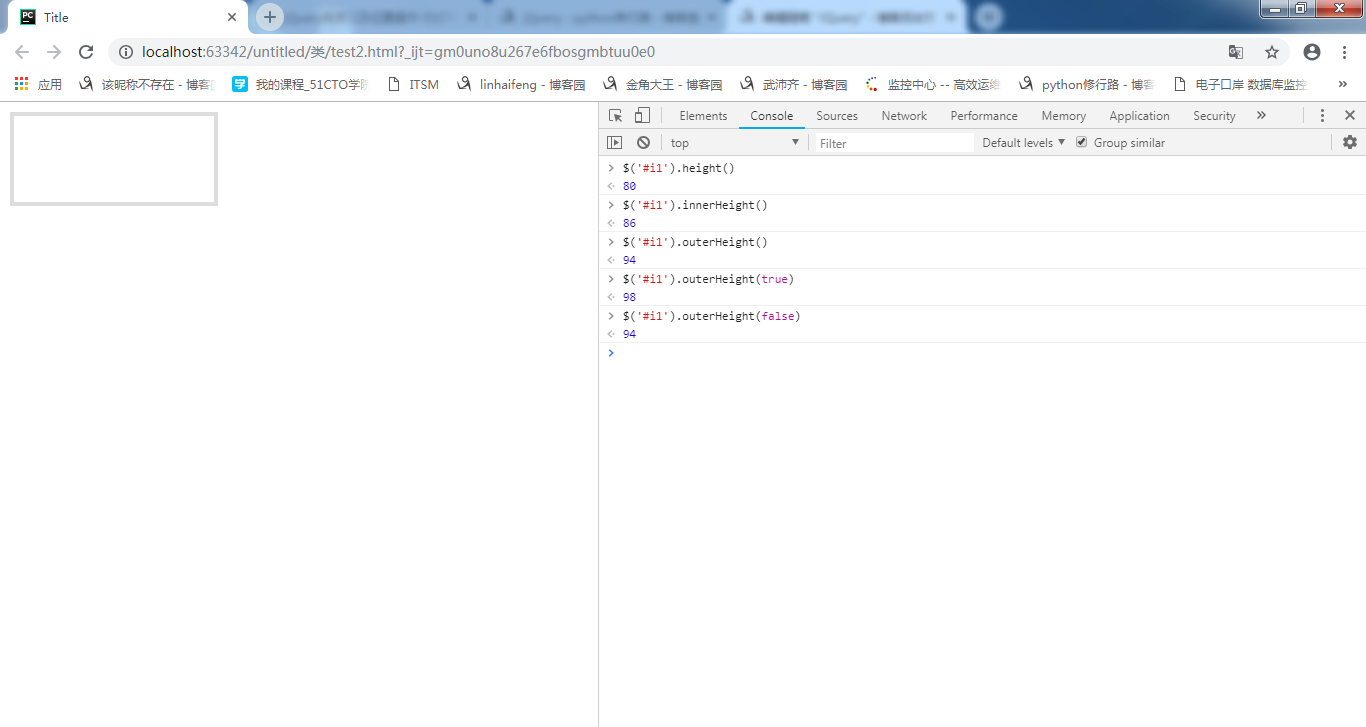
JQuery绑定事件方式
第一种是:
$('.c1').click()等等还有很多
第二种是:(可以绑定同时可以解除绑定)
$('.c1').bind("click",function(){})
$('.c1').unbind('click',function(){})
第三种是:(可以绑定同时可以解除绑定)
$('.c1').delegate('a','click',function(){}) //.c1下的所有a标签绑定一个click事件
$('.c1').undelegate('a','click',function(){})
第四种是:(可以绑定同时可以解除绑定)
$('.c1').on('click',function(){})
$('.c1').off('click',function(){})
以上绑定方式中特殊的是delegate绑定方式:
通过下面例子理解:
<!DOCTYPE html> <html lang="en"> <head> <meta charset="UTF-8"> <title>Title</title> </head> <body> <input id ="a1" type="text"> <input id ="t1" type="button" value="添加"> <ul id ="u1"> <li>1</li> <li>2</li> </ul> <script src="jquery-1.12.4.js"></script> <script> $("#t1").click(function () { var v = $("#a1").val(); var temp = "<li>"+v+"</li>"; $("#u1").append(temp); }); $('ul li').click(function () { var v = $(this).text(); alert(v) }) </script> </body> </html>
上面代码中给li绑定click是通过第一种方式绑定的,通过.click()、bind()、以及on三种方式绑定的时候后续增加的li标签点击的时候是不会有弹框的,只有将li的click绑定方式用delegate方式绑定就可以实现后续添加的li仍然可以绑定click事件:
$('ul').delegate('li','click',function () { var v = $(this).text(); alert(v); })
这种方式在其他语言中加做委托,只有当点击的时候才会绑定时间并执行
默认先不绑定
关于自身跳转和人为绑定跳转
<body>
<a onclick="ClickOn()" href="http://www.baidu.com">百度1</a>
<script>
function ClickOn() {
alert(123);
}
</script>
</body>
这样运行的时候,默认先弹框,然后才会跳转到百度,也就是先执行我们后天绑定的事件,然后执行标签本身具有的事件,即后天绑定的事件的优先级高于本身具有的事件
如果不想要执行标签本身具有的属性,需要在绑定的事件最后加上:
return false
<body>
<a onclick="return ClickOn()" href="http://www.baidu.com">百度1</a>
<script>
function ClickOn() {
alert(123);
return false
}
</script>
</body>
上述是以Dom方式实现,同样通过jQuery也是相同的:
<body>
<a id="i1" href="http://www.baidu.com">百度1</a>
<script src="jquery-1.12.4.js"></script>
<script>
$('#i1').click(function () {
alert(456);
return false
})
</script>
</body>
表单提交例子
代码如下:
<!DOCTYPE html> <html lang="en"> <head> <meta charset="UTF-8"> <title>Title</title> <style> .error{ color: red; } </style> </head> <body> <form id = "f1" action="ss4.html" method="POST"> <div><input name="n1" type="text" /></div> <div><input name="n2" type="password" /></div> <div><input name="n3" type="text" /></div> <div><input name="n4" type="text" /></div> <input type="submit" value="提交"/> </form> <script src="jquery-1.12.4.js"></script> <script> $(":submit").click(function () { $('.error').remove(); var flag=true; $('#f1').find("input[type='text'],input[type='password']").each(function () { var v = $(this).val(); if (v.length<=0){ //当输入框没有输入内容的时候 flag = false; var tag = document.createElement("span"); tag.className='error'; tag.innerHTML="必填"; $(this).after(tag); //这里的return false只能终止当前循环,并不能阻止事件的提交 //return false; } }); return flag; }) </script> </body> </html>
实现效果如下:
默认什么都不输入直接提交,提示必填
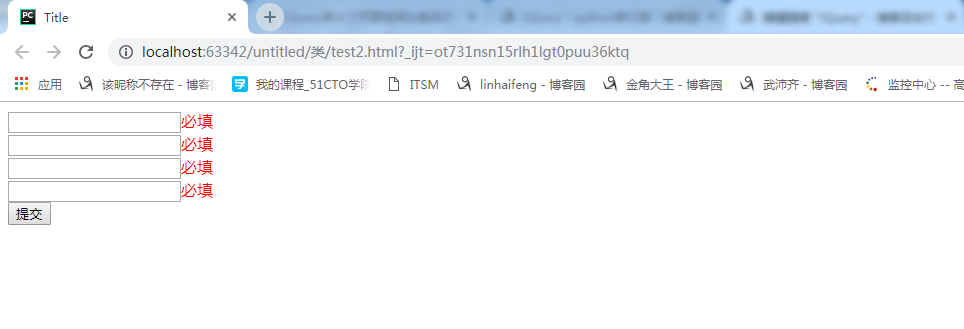
当填写一个之后点击提交,第一个的就会不再提示必填

只有当全部填写内容之后才会提交
当页面框架加载完毕之后自动执行
$(function(){})
一般默认把绑定事件或默认要执行的操作都放到这个里面,如下:
<!DOCTYPE html> <html lang="en"> <head> <meta charset="UTF-8"> <title>Title</title> <style> .error{ color: red; } </style> </head> <body> <form id = "f1" action="ss4.html" method="POST"> <div><input name="n1" type="text" /></div> <div><input name="n2" type="password" /></div> <div><input name="n3" type="text" /></div> <div><input name="n4" type="text" /></div> <input type="submit" value="提交"/> </form> <script src="jquery-1.12.4.js"></script> <script> //当页面框架加载完毕后,自动执行 $(function () { //当页面所有元素完全加载完毕后,执行 $(":submit").click(function () { $('.error').remove(); var flag=true; $('#f1').find("input[type='text'],input[type='password']").each(function () { var v = $(this).val(); if (v.length<=0){ //当输入框没有输入内容的时候 flag = false; var tag = document.createElement("span"); tag.className='error'; tag.innerHTML="必填"; $(this).after(tag); //这里的return false只能终止当前循环,并不能阻止事件的提交 //return false; } }); return flag; }) }) </script> </body> </html>
JQuery扩展
有两种方式:
-.extend调用的时候.extend调用的时候.方法
<body>
<script src="jquery-1.12.4.js"></script>
<script>
//JQuery扩展方式一
$.extend({
'zhangsan':function () {
return 'sb';
}
});
//调用扩展的方法
var v = $.zhangsan();
alert(v)
</script>
</body>
-.fn.extend调用的时候.fn.extend调用的时候(..).方法
<body>
<script src="jquery-1.12.4.js"></script>
<script>
//JQuery扩展方式二
$.fn.extend({
'lisi':function () {
return 'db';
}
});
//调用扩展的方法
var v = $('#i1').lisi();
alert(v)
</script>
</body>
注意:需要将扩展放到自执行函数里,以避免全局变量冲突的问题
(function(arg){ var status = 1 arg.fn.extend({ 'lisi':function () { return status; } }); })(jQuery)

